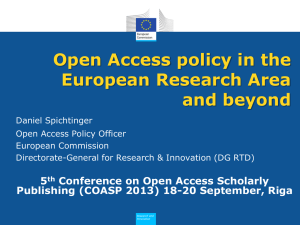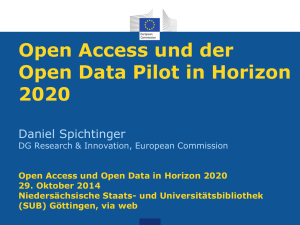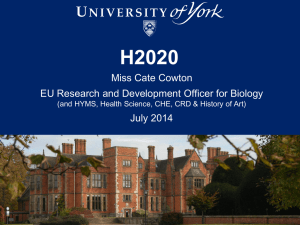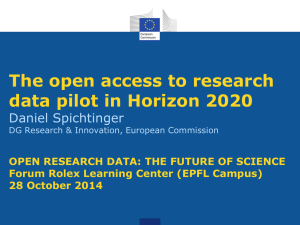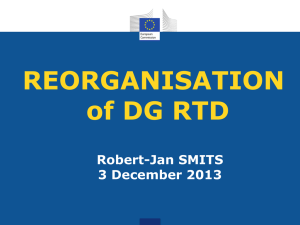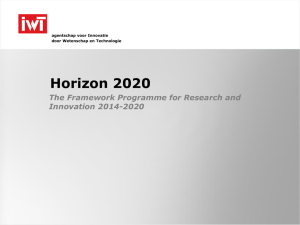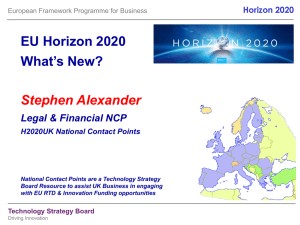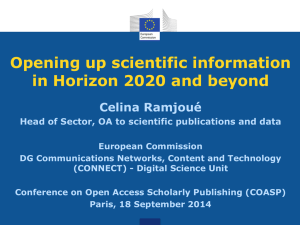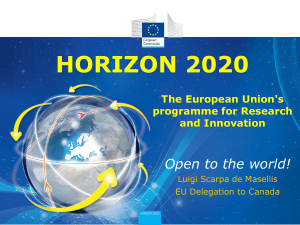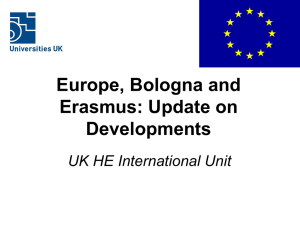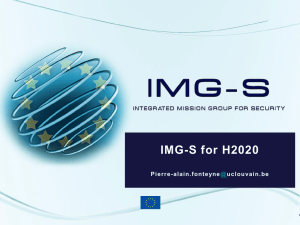Open access in Horizon 2020
advertisement
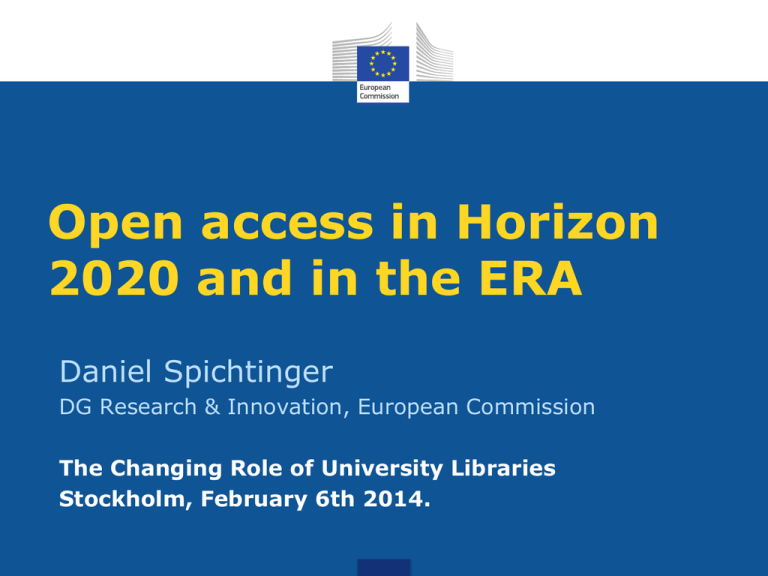
Open access in Horizon 2020 and in the ERA Daniel Spichtinger DG Research & Innovation, European Commission The Changing Role of University Libraries Stockholm, February 6th 2014. Content 1. 1. What is open access 1. 2. Open Access Policy: The ERA and the Communication/Recommendation on scientific information 2. 3. Open Access in FP7 3. 4. Open Access in Horizon 2020 4. 5. The international landscape 5. 6. Upcoming challenges and conclusions What do we understand by OA? OA = online access at no charge to the user • to peer-reviewed scientific publications • to research data Two main OA publishing business models • Self-archiving: deposit of manuscripts & immediate/delayed OA provided by author ("Green OA") • OA publishing: costs covered & immediate OA provided by publisher ("Gold OA") e.g. 'Author-pay' model (APC) and others, e.g. sponsorship What OA is NOT • Not an obligation to publish • Not at odds with patenting • OA publications go the same peer review process Dissemination and exploitation The European Commission is a... Policy maker • It proposes EU legislation & legislates with other EU institutions • It invites Member States to act Funding agency • It sets its own access and dissemination rules for EC-funded research Capacity builder • It funds projects that support EC/EU policy (e.g. eInfrastructure) The Commission objective The Commission wants to optimise the impact of publiclyfunded scientific research • At European level (FP7 & Horizon 2020) • At Member State level One way to get there: open access Expected benefits: • Better and more efficient science Science 2.0 • Economic growth Innovation Union • Broader, faster, more transparent and equal access for the benefit of researchers, industry and citizens Responsible Research and Innovation … in the European Research Area and beyond Two Commissioners on open access Vice-President Neelie Kroes Digital Agenda Digital single market/Digital agenda Commissioner Máire Geoghegan-Quinn Research & Innovation Horizon 2020 European Research Area (ERA) & Innovation Union Three key documents (16.07.2012) Communication 'A reinforced European Research Area partnership for excellence and growth' Communication 'Towards better access to scientific information: boosting the benefits of public investments in research' Recommendation on access to and preservation of scientific information 1. Communication 'ERA' The ERA is based on the internal market in which researchers, scientific knowledge and technology circulate freely Five priority areas: • • • • • More effective national research systems Optimal transnational cooperation and competition An open labour market for researchers Gender equality and gender mainstreaming in research Optimal circulation, access to and transfer of scientific knowledge Joint statement by stakeholders organisations Formal commitments and activities on open access by: EARTO, NordForsk, Science Europe, LERU and EUA Communication 'ERA' MS are invited to coordinate their policies on access to and preservation of scientific information Recommendation on access to and preservation of scientific information (C(2012)4890). SHO are invited to adopt and implement open access measures for publications and data resulting from publicly funded research Signed Memorandum of Understanding with LERU, EARTO, EUA, NORDFORSK and Unilateral Statement by Science Europe The Commission will adopt establish open access to scientific publications as a general principle for all EU funded research projects in Horizon 2020. For research data the EC will develop a flexible approach that takes into account different scientific areas and business related interests. The Commission will continue to fund projects related to open access Communication 'Towards better access to scientific information', COM(2012)401 2. Communication 'Towards better access to scientific information' Why does better access matter for Europe? The Commission's vision Where do we stand? • Access to publication and data, preservation, international context What are the barriers to change? • Transition to OA to publications, the case of data, long-term preservation Action at European level • What has the Commission done so far, what are the next steps (Horizon 2020) 3. Recommendation to Member States Member States to define policies for and implement: • • • • OA to publications OA to research data Preservation and re-use of scientific information E-infrastructures Consistency between H2020 policy and MS policy Structured co-ordination of MS (National Points of Reference) at EU-level and reporting Open access in the ERA (2013) Member States (MS) ERA Progress Report (2013): progress among MS "gradual yet visible" (legal and administrative) but efforts need to continue. For interaction with the EC and among each other MS have nominated a national Point of Reference (NPR) First meeting of NPRs held in 2013 Commissioner Geoghegan-Quinn participated in a Competitiveness Council debate on open access Stakeholder Organisations (SHO) Significant interest in the subject, have organised a variety of events, many of them with Commission (e.g. LERU Conference of 2012, Nordforsk Open Data Workshop, COST workshop, a the Science Europe ERA Europe High Level Workshop). Open access also a point for discussion in the ERA High Level Stakeholder Platform and the associated doers network. ERA Progress Report (2013): Significant number of Research Funders and Research Performing Organisations support OA on the national level Open access in FP7 OA publishing costs are eligible in FP7 • Since the beginning of FP7, for all projects • Limited to duration of project OA Pilot in FP7 • Best effort basis • 7 areas (>1500 projects to date) • 20% of total FP7 budget (2007-2013) • 6/12-month embargo OpenAIRE • EU-funded portal giving access to repositories across Europe (implements FP7 Pilot) • 45.000 publications, 19.000 OA, 25.000 still under embargo FP7 coordination and support actions PASTEUR4OA (Open Access Policy Alignment Strategies for European Union Research) NEW 2014 FOSTER (Foster Open Science Training for European Research) NEW 2014 RECODE - (Policy Recommendations for Open Access to Research Data in Europe) - 2013 SERSCIDA - (Support for Establishment of National/Regional Social Sciences Data Archives) - 2011 MEDOANET - (Mediterranean Open Access Network) - 2011 SISOB - (An Observatorium for Science in Society based in Social Models) - 2010 ACUMEN - (Academic Careers Understood through Measurement and Norms) - 2009 Call in 2014/15 SWAFS Work Programme GARRI.3.2014 Scientific information in the digital age: text and data mining (TDM) • Study TDM in the modern research environment GARRI.4.2015 Innovative approach to release and disseminate research results and measure their impact • • • • Need to examine the situation from A to Z How peer-review develops outside of traditional methods How indicators and bibliometrics are adequate Support and promotion actions Open access in Horizon 2020: where to look • Regulation establishing Horizon 2020 • Rules for Participation • Work Programme 2014-15 • Model Grant Agreement • Annotated Model Grant Agreement • Guidelines on Open Access in Horizon 2020 Open access in Horizon 2020 Regulation establishing Horizon 2020 To increase the circulation and exploitation of knowledge, open access to scientific publications should be ensured. Furthermore, open access to research data resulting from publicly funded research under Horizon 2020 should be promoted, taking into account constraints pertaining to privacy, national security and intellectual property rights. Open access to scientific publications resulting from publicly funded research under Horizon 2020 shall be ensured [...]. Open access to research data resulting from publicly funded research under Horizon 2020 shall be promoted. [...]. A lengthy process of agreement between all parties! From FP7 to H2020: OA to publications from pilot to underlying principle FP7 • Green open access pilot in 7 areas of FP7 with 'best effort' stipulation • Allowed embargoes: 6/12 months • Gold open access costs eligible for reimbursement as part of the project budget while the project runs • • • • Horizon 2020 Obligation to provide OA, either through the Green or Gold way in all areas Allowed embargoes: 6/12 months Gold open access costs eligible for reimbursement as part of the project budget while the project runs & post-grant support being piloted Authors encouraged to retain copyright and grant licences instead OA to publications mandate in H2020 Each beneficiary must ensure OA to all peer-reviewed scientific publications relating to its results: • Deposit a machine-readable copy of the published version or final peer-reviewed manuscript accepted for publication in a repository of the researchers choice (possibly OpenAIRE compliant) • Ensure OA on publication or at the latest within 6/12 months • Ensure OA to the bibliographic metadata that identify the deposited publication, via the repository • Aim to deposit at the same time the research data needed to validate the results ("underlying data") Pilot on Open Research Data in H2020 Three key questions: • Which thematic areas should be covered? • What kind of data should be covered? • What about data management? Pilot on Open Research Data in H2020 Areas of the 2014-2015 Work Programme participating in the Open Research Data Pilot are: • Future and Emerging Technologies • Research infrastructures – part e-Infrastructures • Leadership in enabling and industrial technologies – Information and Communication Technologies • Societal Challenge: Secure, Clean and Efficient Energy – part Smart cities and communities • Societal Challenge: Climate Action, Environment, Resource Efficiency and Raw materials – except raw materials • Societal Challenge: Europe in a changing world – inclusive, innovative and reflective Societies • Science with and for Society Projects in other areas can participate on a voluntary basis. Pilot on Open Research Data in H2020 Types of data concerned: • Data needed to validate the results presented in scientific publications ("underlying data") • Other data as specified in data management plan (=up to projects) Beneficiaries participating in the Pilot will: • Deposit this data in a research data repository of their choice • Take measures to make it possible to access, mine, exploit, reproduce and disseminate free of charge • Provide information about tools and instruments at the disposal of the beneficiaries and necessary for validating the results (where possible, provide the tools and instruments themselves) EC: Support & monitoring (Annotated MGA, Specific guidance etc…) Data management in Horizon 2020 • Data Management Plans (DMPs) mandatory for all projects participating in the Pilot, optional for others • DMPs are NOT part of the proposal evaluation, they need to be generated within the first six months of the project and updated as needed • DMP questions: •What data will be collected / generated? •What standards will be used / how will metadata be generated? •What data will be exploited? What data will be shared / made open? •How will data be curated and preserved? The international landscape (1/3) Study to measure the growth of OA • Focus on ERA, Brazil, Canada, Japan and USA • 2008–2011: 21 out of 28 EU MS have achieved a majority of OA papers by April 2013. During this period eight of the EU28 countries have reached a 'tipping point' of 50% of papers available in OA (EU average: 45%) • 15 Member States reported to have implemented OA national measures (stakeholder actions appear in 10 others) • Emergence of OA with a dominance of 'Green' and 'hybrid' OA to publications / Joint initiatives / slow progress of OA to data • Global proportion higher than previously assumed: Around 50% of OA scientific papers published in 2011 More than 40% of OA scientific papers published from 2004-2011 The international landscape (2/3) Study to measure the growth of OA • OA availability varies among disciplines • 'Tipping point' passed in Biology, Biomedical Research, Mathematics & Statistics and in General Science & Technology. Least open access in SSH, applied sciences, engineering and technology • Overall OA advantage occurs in all but four disciplines • The majority of 48 major science funders considers both Gold and Green OA acceptable. More than 75% accepted embargo periods of 6-12 months • Policies for OA to data not as well developed but increasing • http://europa.eu/rapid/press-release_IP-13-786_en.htm The international landscape (3/3) Global Research Council G8 Science UNESCO 'Berlin' conferences on OA Etc. Some milestones 2006 • EC-funded Study on the scientific publication market in Europe 2007 • • • EC Communication on scientific information Council Conclusions on scientific information in the digital age FP7 (OA publishing costs/Gold OA) 2008 • Open Access Pilot in FP7 2009 • OpenAire platform launched to give EU-wide access to publications (and since Dec. 2011: research data) EC Communication on ICT infrastructures for e-Science • 2012 • • • Surveys: OA in FP7, State of play in Member States EC Communication on ERA Scientific information package: EC Communication and Recommendation on scientific information 2013 • • • Public hearing on open research data Open access in Horizon 2020 Open access in the ERA New challenges ahead • Publishing activities: new comers, new business models, new peer review models, new services... • Open science & 'Big Data' • Alternative metrics • Text and Data Mining & Copyright issues A transition from publishing results to releasing results? In summary… • Open access as a means to improve knowledge circulation • Horizon 2020 ambitious yet pragmatic on aspects of open access • Both Green and Gold open access measures are promoted Not all countries are the same Transition period • Support from/for H2020: work programmes e-Infrastructure & Science with and for Society • Open access must be effective, affordable, competitive and sustainable for researchers and innovative businesses We welcome your input Contacts DG RTD Daniel SPICHTINGER (Unit A6, DG RTD) daniel.spichtinger@ec.europa.eu Monica TARAZONA RUA(Unit A6, DG RTD) maria-monica.tarazona-rua@ec.europa.eu Links EC OA website http://ec.europa.eu/research/science-society/open_access Twitter: @OpenAccessEC European Research Area (ERA) http://ec.europa.eu/research/era/index_en.htm Innovation Union http://ec.europa.eu/research/innovation-union/ Study to measure growth of OA http://europa.eu/rapid/press-release_IP-13-786_en.htm H2020 guidance http://ec.europa.eu/research/participants/data/ref/h2020/grants_manual/hi/oa_pilo t/h2020-hi-oa-pilot-guide_en.pdf

